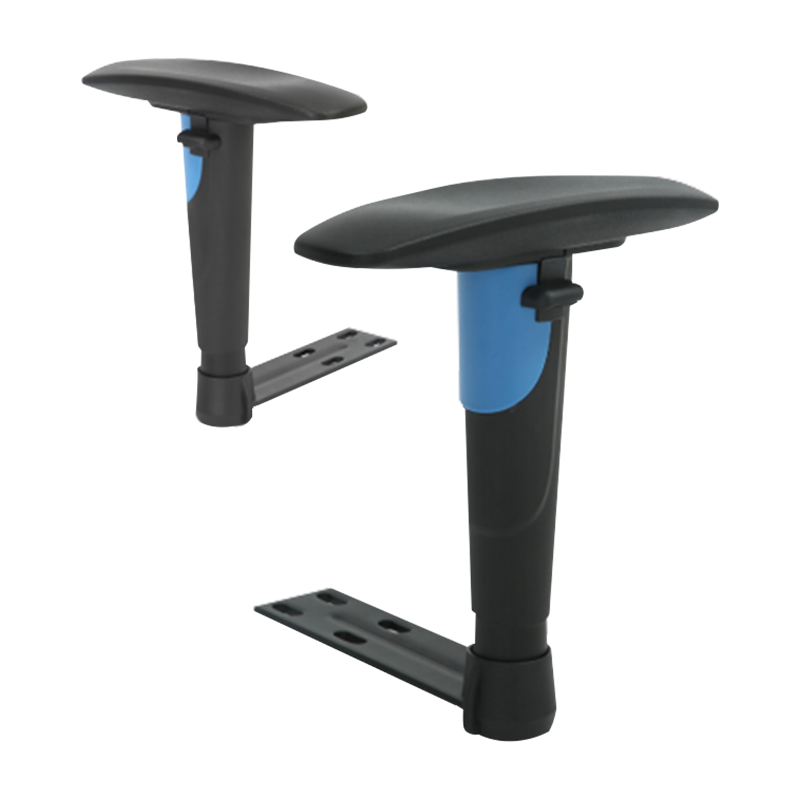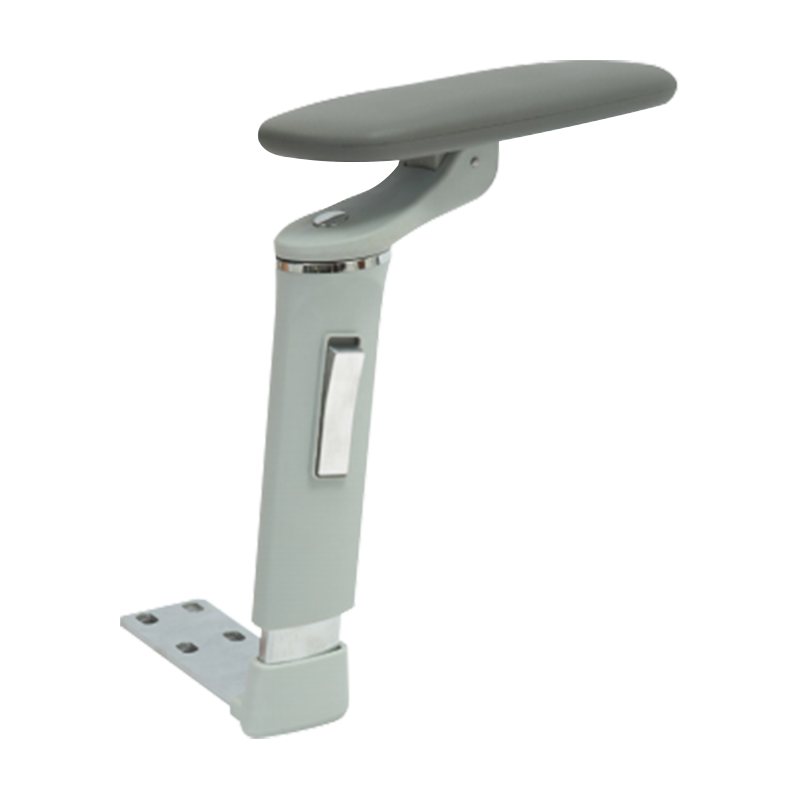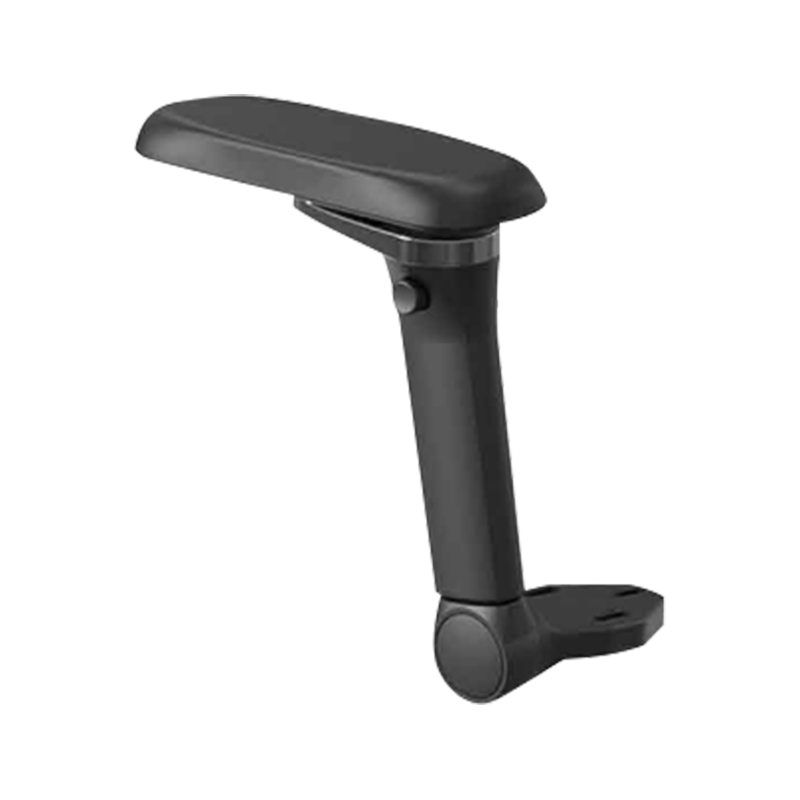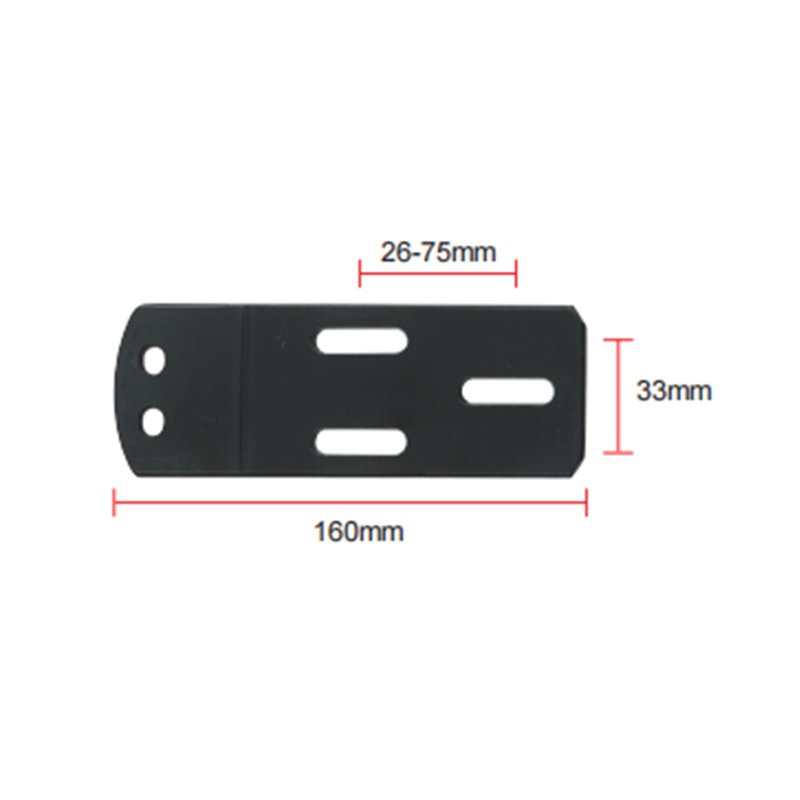Web Menu
Product Search
2D adjustment of office chair armrests: Can widgets leverage major market changes?
- 1 2D handrail technical core: a design philosophy that accurately meets basic needs
- 2 Accurate positioning of application scenarios: "First-needed" accessories in office environments
- 3 Technical iteration: How 2D handrails cope with the challenges of the wave of multifunctionalization?
- 4 Industry Perspective: The Evolution of the Role of 2D Handrails in the Office Furniture Industry Chain
- 5 Future Outlook: Where is the boundary between the living space and innovation of 2D handrails?
In the field of office furniture accessories, 2D Office Chairs Armrest seems to be an inconspicuous widget, but plays a key role in the balance of ergonomics and office efficiency. When the market is generally concerned about multi-functional handrails such as 3D and 4D, 2D handrails still occupy half of office seat accessories due to their cost-effectiveness and practicality. How can this handrail product that only has two-dimensional adjustments to the upper and lower, front and rear find a living space in the market segment? What kind of development trends does its technological iteration and the expansion of application scenarios reflect the office furniture industry?
201 2D Armrest Office Chair Gaming Chair Parts, Adjustable and Replaceable
2D handrail technical core: a design philosophy that accurately meets basic needs
In the wave of intelligence in the modern office environment, the functional iteration of office chair armrests always follows the balance law of pragmatism and humanization. 2D Office Chairs Armrest (two-dimensional office chair armrest) is a model for accurately solving basic needs, and redefines the functional boundaries of office furniture with a "less but refined" design philosophy. This seemingly simple structural design actually contains the deep deconstruction of ergonomics and the precise adaptation of office scenarios, finding a perfect balance between functionality and cost-effectiveness.
-
Functional design logic for precise positioning
In the field of ergonomic research, the golden range of elbow support has always been the core topic of office chair armrest design. The height adjustment function of 2D handrails is not a simple lifting mechanism, but a dynamic adaptation system built on a large amount of anthropometric data. According to the International Ergonomic Association (IEA), the natural sagging height of elbows in Asian adults is usually distributed in the range of 45-53 cm, while the European population is concentrated in 48-56 cm. The 2D handrail has a 5-8 cm adjustment range, covering the elbow support needs of more than 90% of the office population. This precise parameter setting avoids the cost redundancy caused by excessive adjustment.
The design of front and rear adjustment functions is more scene-oriented. Through the behavioral tracking of 3,000 office workers, it was found that the average distance of the elbow extending forward when working at the desk was 12-18 cm, and the distance of the arm moving backward when getting up and leaving the seat was about 8-15 cm. The front and rear adjustment mechanism of the 2D armrests achieves seamless connection between the armrests and the human body movement through the linkage design of the slide rail and the seat chassis. A case of office environment transformation of a multinational enterprise shows that after the introduction of 2D armrest office chairs, the complaint rate of shoulder and neck fatigue caused by poor arm movements decreased by 37%, which indirectly verified the design's accurate adaptation to daily office behavior.
Compared with multi-dimensional adjustment handrails, behind the functional trade-offs of 2D handrails is a deep insight into user behavior. Market research data shows that the additional functions such as tilt and rotation of multi-dimensional adjustment handrails are actually used less than 20%, and the complex operating interface has caused 35% of users to never fully master its full functions. The 2D handrail uses subtraction design to focus the limited structural space on the two most core dimensions, increasing the functional utilization rate to more than 85%, truly achieving the design goal of "making basic functions to the extreme".
-
Innovation and breakthrough in materials science
In terms of material selection, the nylon and fiberglass composite formula used by the 2D handrail is a perfect combination of lightweight and high strength. As the main material, nylon has excellent toughness and chemical stability, while the addition of glass fibers significantly improves the rigidity of the material. Through the special blending process, the material density is precisely controlled at 1.1-1.2g/cm³, which is more than 40% lighter than traditional aluminum alloy armrests, greatly reducing the overall weight of the office chair. At the same time, the tensile strength reaches 75MPa, meeting the strict requirements for armrest load-bearing in the EN 1335 European office chair standard.
The durability test data of the material further highlights the technical advantages of 2D handrails. A bending fatigue test conducted by a third-party testing agency using ISO 178 standard showed that after 100,000 lifting cycles, the modulus attenuation of high-quality 2D nylon handrails was only 3.2%, far below the industry average. The nano-grade polyurethane coating used for the surface wear resistance layer was used. In the Taber wear resistance test, after 5000 rpm, the loss thickness was only 0.15 mm. In combination with the internal reinforcement structural design, the long-term stability of the handrail in a high-frequency use environment is ensured.
The breakthrough in comfort of high-end 2D handrails is also worth paying attention to. Through pressure distribution testing, it was found that traditional hard plastic handrails would form a significant stress concentration area when the elbow was pressed, while 2D handrails covered with PU pads reduced the pressure peak from 0.6MPa to 0.32MPa through optimized surface design and memory foam filling, and increased the pressure distribution uniformity by 60%. This design not only relieves elbow fatigue during long hours of office work, but also reduces the risk of nerve compression by reducing local compression.
-
The pursuit of lean manufacturing technology
The precision manufacturing of 2D handrails is inseparable from advanced injection molding technology. During the mold design stage, CAE mold flow analysis technology is used to simulate material flow and cooling shrinkage. By optimizing gate position and cooling waterway layout, the molding deformation rate of the product is controlled within 0.3%. The two-color injection molding process introduced by a head office furniture manufacturer can complete the composite molding of the main structure and the wear-resistant surface layer during one injection molding process, which not only improves production efficiency, but also avoids the interlayer bonding problems caused by secondary processing.
The quality control system runs through the entire production process. During the raw material storage stage, each batch of nylon pellets needs to undergo 12 tests such as melting index and tensile strength; before the finished product leaves the factory, in addition to conventional load-bearing and fatigue testing, extreme environmental simulations such as salt spray test and high and low temperature cycle test are also added. The quality traceability system of a well-known brand shows that the after-sales failure rate of its 2D handrails has been below 0.8% for three consecutive years. This lean production model ensures a high degree of consistency in product quality.
Accurate positioning of application scenarios: "First-needed" accessories in office environments
In the wave of functional iteration of office furniture, 2D Office Chairs Armrest (two-dimensional office chair armrest) has become an indispensable "firm-needed" accessories in modern office spaces with its precise scene adaptability. This seemingly simple design actually finds the best balance between functionality, durability and economy through in-depth interpretation of user needs in different scenarios, making it show strong vitality in a diversified office environment.
-
Regular office area: the best interpretation of pragmatism
In the modern office mainstream scenario of open office compartment and employee positions, 2D handrails dominate the market with their "enough and economical" characteristics. According to Gartner survey data, 78% of companies around the world choose to equip 2D armrest office chairs in basic office areas. This choice contains an accurate grasp of employee behavior patterns.
In a regular office scenario, about 60% of the employees’ average 8 hours of working hours a day is used for repetitive operations such as document processing, data entry and video conferencing. The core demand for the handrails of these jobs focuses on stable elbow support and convenient adjustment functions. The height adjustment range of the 2D handrail (5-8 cm) just covers the golden range of natural support for the elbow of Asian adult employees, while the front and rear adjustment functions perfectly adapt to the employees' movement trajectory when keyboard operation and getting up to communicate. A case of station renovation of an Internet company shows that after the introduction of 2D armrest office chairs, the employee's work efficiency decline caused by arm fatigue was reduced by 42%, and the company's procurement costs were reduced by 18%, achieving dual optimization of efficiency and cost.
Compared with multi-dimensional adjustable handrails, 2D handrails have more significant advantages in regular office areas. User behavior analysis of an international office furniture brand shows that the actual usage rate of the complex functions of multi-dimensional handrails in daily office is less than 30%, while the usage rate of the basic adjustment function of 2D handrails is as high as 91%. This "precise matching needs" design concept makes 2D handrails an ideal choice for enterprises to control operating costs and improve employee comfort.
-
Education and training venues: dual considerations of durability and economics
In high-frequency use scenarios such as school classrooms and enterprise training rooms, 2D handrails show unique applicability. The characteristics of these places are high personnel mobility and high usage intensity, which puts forward strict requirements on the durability and maintenance costs of office furniture. According to research by the International Association for Educational Facilities Planning (CEFPI), the average annual number of office chairs in educational venues is 3-5 times that of ordinary office scenarios, making durability a primary consideration.
The minimalist structural design of 2D handrails is the key to addressing this challenge. The nylon and fiberglass composite material is made of nylon and fiberglass. After 100,000 lifting cycles, the structural deformation rate is less than 1%, and the wear-resistant layer loss thickness does not exceed 0.3 mm, far exceeding the standard requirements of the education industry for furniture durability. The procurement manager at a vocational training school said: "In the past, multi-function armchairs used required an average of 5-8 repairs per month. After replacing them with 2D armchairs, the annual repairs dropped to less than three times, saving 65% of maintenance costs."
In terms of cost control, the advantages of 2D handrails are also outstanding. Its simple mechanical structure greatly reduces the difficulty of repair, and the cost of replacing accessories is only 1/3 of that of multi-function handrails. Procurement data from a chain of educational institutions show that after the use of 2D armchairs, the annual furniture maintenance budget of its single campus has been reduced by 220,000 yuan, and this fund can be converted into teaching equipment upgrades to achieve efficient utilization of resources.
-
Home office scenario: The winning way of cost-effectiveness
With the popularity of remote office, home office scenarios have become an emerging growth market for 2D handrails. According to Statista, the global home office chair market size exceeded US$15 billion in 2023, of which products equipped with 2D handrails account for more than 55% of the market share. Behind this phenomenon is the urgent need for a balance between price and practicality by home users.
When purchasing office chairs, family users often pay more attention to the cost-effectiveness of the product. The 2D handrail not only meets the basic comfort needs of working from home, but also avoids the increase in costs due to overfunction. Its height and front and rear adjustment functions are sufficient to adapt to a variety of home office scenes—whether it is long-term computer writing or temporary video conferencing, the 2D handrail provides stable support. Sales data from an e-commerce platform show that the repurchase rate of 2D armrest office chairs with prices in the range of 500-1,000 yuan reached 28%, significantly higher than similar multifunctional products.
In addition, the simple design of 2D handrails and the adaptability of the home environment are also an important reason for their popularity. Its lightweight structure is easy to move and store, and a variety of colors and materials are selected to allow it to be integrated into different decoration styles. A freelancer wrote in the product review: "This 2D armchair perfectly solves my home office needs, does not take up space, adjusts functions and is very practical, and has a much better price-performance ratio than expected."
-
Rational choice in high-end office environment
Even in a high-end office environment that pursues the ultimate experience, 2D handrails have won a place with their pragmatic design philosophy. The head of the administrative department of a multinational enterprise revealed: "We equipped 4D armchairs worth tens of thousands of yuan in the executive office, but we still chose 2D products in the ordinary employee area - it is not that the functions are insufficient, but that 2D handrails can meet the core needs of daily 8-hour office work, and have obvious cost-effectiveness advantages."
Behind this choice is a rational consideration of cost-effectiveness. In high-end office environments, companies usually invest high-end equipment in core decision-making areas, while in basic office areas, they pay more attention to practicality and cost control. The annual procurement cost of 2D handrails is only 1/5 of that of 4D handrails, but the basic support functions it provides are enough to meet the daily needs of ordinary employees. A case of office space renovation of a financial institution shows that by reasonably configuring 2D and 4D armchairs, the overall procurement cost of office furniture is reduced by 30% while ensuring the office experience of senior executives.
In addition, the environmentally friendly attributes of 2D handrails also make them more competitive in high-end office scenarios. Its recyclable materials and low-energy production process are in line with the pursuit of sustainable development of modern enterprises. Data from a green building certification agency shows that office chairs using 2D armrests have a full life cycle carbon footprint of 35% lower than metal armrests, which is particularly prominent among high-end companies that focus on environmental protection image.
Technical iteration: How 2D handrails cope with the challenges of the wave of multifunctionalization?
At a time when office chair armrest technology is surging towards multi-dimensional adjustment, 3D and 4D armrests are constantly attracting market attention with their rich functions. However, 2D Office Chairs Armrest did not lose in this technology competition. Instead, through a series of detailed innovations and technological breakthroughs, it has opened up a unique way of survival in the fierce market competition and continuously consolidated its dominant position in the field of basic functions.
-
Adjustment accuracy upgrade: from "enough" to "precise adaptation"
Although the traditional 2D handrail height adjustment mode in units of 1 cm can meet the basic needs of most users, it gradually reveals its limitations in the pursuit of extreme comfort office environment. The new generation of 2D handrails has increased the height adjustment accuracy to 0.5 cm by introducing a sophisticated rack and rack structure, achieving a leap from "rough adaptation" to "precise customization". This structural design uses a meshing transmission between a modular gear and a high-precision rack, and can achieve smooth and stable height adjustment through a stepper motor or a manual knob.
A comparative test of an ergonomic research institution for 300 users of different heights showed that the improved accuracy of 2D handrails can increase the comfort of elbow support by 20%. In actual office scenarios, the effect of this improvement is particularly significant. For users with critical height, 0.5 cm fine adjustment can make the elbow and the tabletop perfectly 90 degrees angle, effectively reducing shoulders
and neck pressure. For example, in a station renovation project of a software development company, after introducing high-precision 2D handrails, employees' fatigue caused by improper arm support was significantly reduced, and their work efficiency was increased by 12%. In addition, the new generation of 2D handrails also add a damping feedback mechanism during the adjustment process, allowing users to feel a clear sense of paragraphs during operation, which not only avoids excessive adjustment but also enhances the texture of the operation.
-
Lightweight and load-bearing balance: the wisdom of material innovation
In the pursuit of lightweight office furniture, 2D handrails have successfully achieved a perfect balance between lightweight and load-bearing capacity by optimizing the nylon material formula. By adding special nano-scale reinforced fibers and adjusting the content and distribution of glass fibers, the R&D team reduces the weight of a single handrail by 15%-20% while ensuring the load-bearing capacity of 70kg. This material innovation not only improves the portability of office chairs, but also meets the need for frequent adjustment of stations in modern office environments.
Test data from an office furniture manufacturer showed that the improved 2D handrail was still intact after 5,000 70kg load cycles in load-bearing tests, proving that it was lightweight without sacrificing durability. In a shared office space, the advantages of lightweight 2D handrails are fully demonstrated. Users can easily move their office chairs and quickly adjust the seat layout according to different collaboration scenarios without worrying about damage to the armrests due to frequent movement. In addition, the lightweight design also reduces the transportation cost and energy consumption of office chairs, which is in line with the development trend of green offices and further enhances the market competitiveness of 2D handrails.
-
Modular design: low-cost function expansion
In order to meet the increasingly diverse needs of users, the 2D handrail industry has launched a "2D+" modular design solution. This design concept breaks the limitations of the traditional 2D handrail function. Users can purchase additional rotation modules, soft-up accessories or heating modules according to their own needs based on the basic 2D adjustment function. The core of modular design lies in the application of standardized interfaces, which ensures compatibility and interchangeability between different modules through unified installation sizes and connection methods.
In the customized e-commerce services, the "2D+" modular solution is very popular. Data from an office furniture e-commerce platform shows that after the launch of modular 2D handrails, the average customer price of related products increased by about 30%, and the user repurchase rate also increased by 18%. For example, for users who need to conduct frequent video conferencing, they can purchase modules with rotation functions to enable the handrail to flexibly turn and facilitate communication with others; for users who pursue extreme comfort, they can add memory foam pads to effectively relieve elbow pressure. This "on-demand customization" model not only meets the personalized needs of users, but also avoids the increase in costs caused by functional redundancy, achieving a win-win situation between user experience and economic benefits.
Industry Perspective: The Evolution of the Role of 2D Handrails in the Office Furniture Industry Chain
In the wave of rapid development and change in the office furniture industry, the role of 2D Office Chairs Armrest has long gone beyond the scope of pure accessories. With changes in market demand, technology iteration and the reshaping of the global industrial structure, its position and role in the industrial chain have been constantly evolving, from traditional standardized production of accessories to a key force driving industrial upgrading and expanding market boundaries.
-
Supply chain integration: dual driving force of scale and cost advantages
Upstream of the office furniture industry chain, the production and manufacturing of 2D handrails are undergoing in-depth supply chain integration. With its strong procurement capabilities and production scale, leading accessories manufacturers have gradually established unshakable competitive barriers. According to authoritative industry data statistics, enterprises whose nylon raw materials purchase volume accounts for more than 30% of the industry can obtain a 10%-15% discount on the raw material price of 10%-15% based on the advantages of centralized procurement. This cost advantage is not only reflected in the raw material procurement process, but also further amplified through large-scale production.
Taking a globally renowned office furniture accessories supplier as an example, by laying out production bases around the world, it has achieved full-chain coverage from nylon raw material processing, mold manufacturing to finished product assembly. With the annual production scale of 2D handrails of over one million pieces, the company has reduced the production cost of a single piece to 70% of the industry average. This cost advantage makes them have stronger pricing power in the terminal market, forming a price barrier that other small and medium-sized enterprises are difficult to break through. At the same time, leading companies have established long-term strategic cooperative relationships with raw material suppliers to ensure the stable supply of key raw materials and are more resilient in responding to market fluctuations.
Supply chain integration is also reflected in the collaborative innovation of production technology. Large enterprises often invest a lot of resources in research and development to promote innovation in production processes. For example, in the injection molding process, by introducing automated production lines and intelligent monitoring systems, the product failure rate is reduced from 3% to 0.5%, greatly improving production efficiency and product quality. This technological advantage further consolidates the dominance of leading enterprises in the industrial chain and also prompts the entire industry to develop towards intensive and large-scale.
-
Cross-border e-commerce opportunities: the rise of emerging markets and the release of product value
Driven by the wave of globalization and digitalization, cross-border e-commerce has opened up a new market growth space for 2D handrails. In emerging office furniture markets such as Southeast Asia and the Middle East, 2D handrails quickly opened up the situation with their cost-effective advantages and became the main export force. According to data from a cross-border e-commerce platform, overseas sales of 2D handrail products increased by 45% year-on-year in 2023, of which the growth rate of India, Vietnam and other countries exceeded 60%.
This rapid growth is due to many factors. First of all, the demand for office furniture in emerging markets is in a period of rapid growth. With the development of the economy in Southeast Asia and the Middle East, the office environment of enterprises has been upgraded and new office spaces have increased, and there are strong demand for office chair accessories with reasonable prices and practical functions. The characteristics of 2D handrails "precisely solve basic needs" are exactly in line with the actual needs of these markets. Secondly, cross-border e-commerce platforms have broken the geographical restrictions and channel barriers of traditional trade, allowing Chinese 2D handrail manufacturers to directly reach overseas end customers, reducing intermediate links, reducing sales costs, and further enhancing the price competitiveness of products.
In addition, the big data analysis function of cross-border e-commerce also provides strong support for the market expansion of 2D handrails. By analyzing overseas users’ search keywords, purchase preferences and evaluation feedback, manufacturers can adjust product design and marketing strategies in a timely manner. For example, in response to the gorgeous appearance needs of users in the Middle East, some manufacturers have launched 2D handrails with exquisite carving decorations; in response to the special requirements of the Southeast Asian market for moisture resistance, the waterproof treatment process of the material has been optimized. These customized improvements based on market demand have further improved the adaptability and competitiveness of the products in overseas markets.
-
Impact of environmental protection trends: Green transformation reshapes the competitive landscape of the industry
With the increasing global environmental awareness and the increasingly strict environmental regulations of various countries, the 2D handrail industry is facing profound pressure on green transformation and is also ushering in new development opportunities. EU EPAC regulations put strict requirements on the environmental protection of office furniture materials, stipulating that the content of harmful substances in products must be lower than specific standards, and the use of renewable materials is encouraged. This policy orientation has prompted 2D handrail manufacturers to accelerate their transformation to an environmentally friendly production model.
At present, industry-leading companies have made significant progress in the application of environmentally friendly materials. By using recycled nylon materials, these companies can use 30%-50% recycled materials in their products while ensuring that the product performance is not lower than that of traditional materials. Taking a leading domestic company as an example, the new recycled nylon 2D handrail it developed not only reduces carbon emissions by more than 30%, but also makes the tensile strength and wear resistance of the product reach or even exceed the original material standards through special modification processes. This environmental transformation not only helps enterprises meet the access requirements of the international market, but also paves the way for them to enter the high-end market.
The trend of environmental protection has also promoted the coordinated upgrade of the entire industrial chain. From raw material suppliers to downstream office furniture brands, everyone is actively seeking green solutions. For example, some nylon raw material suppliers have increased their investment in research and development and production of recycled nylon, while office furniture brands are more inclined to purchase environmentally certified 2D handrails to enhance the green competitiveness of their own products. This upstream and downstream collaborative transformation is reshaping the competitive landscape of the office furniture industry chain. Those companies that can take the lead in completing green transformation will occupy an advantageous position in future market competition.
2D Office Chairs Armrest's role evolution in the office furniture industry chain is the result of the combined role of market demand, technological innovation and policy orientation. From the cost advantages brought by supply chain integration, to the market opportunities created by cross-border e-commerce, to the green transformation driven by environmental protection trends, 2D handrails are playing an increasingly important role in the industrial chain with a continuous innovation attitude. In the future, with the continuous development of the industry, 2D handrails are expected to achieve new breakthroughs in the fields of intelligence and modularity, and continue to lead the innovation and transformation of the office furniture accessories industry.
Future Outlook: Where is the boundary between the living space and innovation of 2D handrails?
As the office furniture industry continues to evolve towards intelligence and multifunctionality, the future development of 2D Office Chairs Armrest faces dual challenges: on the one hand, the price of multifunctional handrails is declining year by year, and the price difference between 3D products and 2D products has shrunk from 50% in 2018 to 30% in 2023, which may squeeze the market space of 2D handrails; on the other hand, the improvement of users' awareness of healthy office may prompt more people to be willing to pay a premium for additional functions.
But from another perspective, the "minimalism" of 2D handrails may also become a new competitive advantage. Against the backdrop of the rise of the concept of "sustainable office", the 2D handrails with simple structure, convenient maintenance and long service life are more in line with the requirements of the circular economy. A survey by an environmental protection organization showed that the average maintenance rate of 2D handrails is 40% lower than that of 4D handrails, and the material recycling rate after being discarded is 25%, which gives it an advantage in the green office procurement list.
Perhaps as an office furniture designer said: "The value of 2D handrails does not lie in the number of functions, but in the most economical way to solve the most core needs." Today, with diversified office scenes and differentiated user needs, 2D Office Chairs Armrest still occupies an irreplaceable position in the market with its precise grasp of "basic demand". When the industry focuses more on "additional innovation", the "subtraction philosophy" represented by 2D handrails may provide another idea for the development of office furniture accessories - after all, true pragmatism is never a stacking function, but using the right solution to solve the most essential problems in the right scenario. For 2D handrails, its future innovation direction may be hidden in the design philosophy of "less is more", waiting for the industry to further explore and explore.
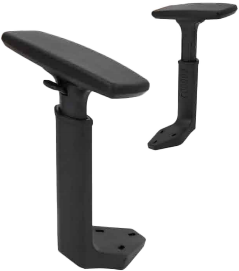
 Feel free to contact us
Feel free to contact us
- Product Fast Links
- Office Chair Armrest
- Hardware Steel Plate
- Polyurethane PU Surface
- Casters
- Contact Information
- Tangpu Industrial Park, Anji County, Huzhou City, Zhejiang Province, China
- [email protected]
- +86-13567973388



 English
English  Español
Español  عربى
عربى 
